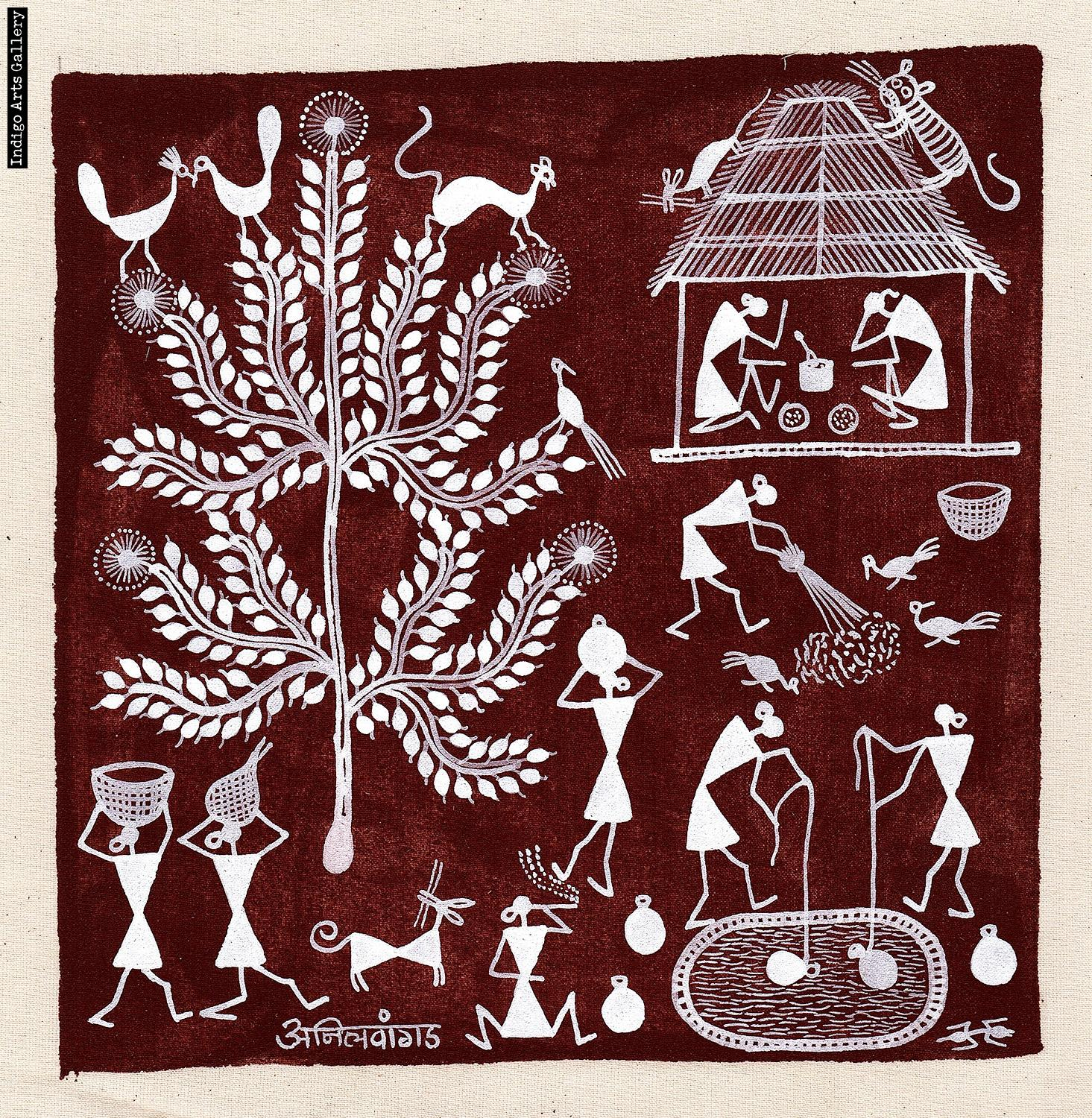Warli Painting - Indian Artwork
Warli's painting comes from India. It is a traditional folk-style painting in Maharashtra, located in the western peninsular region of India. The Warli people are among the largest tribes in India. Warlie painting dates back to the 10th century A.D. and is still practiced today. The painting depicts visual artwork from Mother Nature and the different elements of nature. Warli was originally painted on the walls of huts, passing on folktales, history, and legends of their indigenous tribe. Today, they are painted on cloth or canvas. They use rice paste, cow dung, soil, and leaves for natural color.
Their painting consists of geometric shapes like circles, triangles, and squares. These shapes symbolize different elements of nature. Circles represent the sun or moon. Triangles represent the mountains and trees. Squares represent human invention.
Warli Paintings
Warli people
Maharashtra, India. c.2022
Artist: Anil Vangad
White acrylic paint on red clay pigment painted on cotton fabric
Dimensions: 9" x 9.5" on 12" x 12" sheet
This painting depicts the people in their village, including what looks like a couple of them packing water, another carrying a container on their head, another person gathering wheat or rice on the ground with birds ready to peck at what the person is sweeping, another person playing some type of instrument like a flute, and lastly, a tree. Triangles, ovals, circles, and lines create the picture.
~~~~~~~~~~~~~~~~~~~~~~~~~~~~~~~~~~~~~~~~~~
Artist: Jivya Soma Mashe (1934-15 May 2018)
This painting depicts the circle of life. The swirl of people symbolizes dancing. People are made with basic shapes such as triangles, lines, and circles. Paintings of huts, trees, birds, animals, and the sun and moon reflect their life in their village.
~~~~~~~~~~~~~~~~~~~~~~~~~~~~~~~~~~~~~~~~~~
Rituals in Harmony
Artist: Ramesh Hengadi
In this painting, she depicts traditional Indian ceremonies and the people performing rituals and ceremonial activities. In their culture, they respect the cultural traditions and are of oneness with one another, the animals, and the land.
~~~~~~~~~~~~~~~~~~~~~~~~~~~~~~~~~~~~~~~~~~~~
I personally would have one of these paintings. I can relate to their unity and respect for the animals and the land. They also have rituals, just like our own rituals here in Alaska. They dance in their tradition and we dance as well. In our culture, we once had mud/sod houses just as they have their huts. We may not have the same type of weather, but we seem to both have respect for nature and work together as a community.
Sources:
Marjoto, T. (ed.) (2024) Indian artistry: 10 distinct types of paintings in India - art blogs & videos: Learn art investment: Explore, experience art, Art Blogs & Videos | Learn Art Investment | Explore, Experience Art. Available at: https://blog.mojarto.com/indian-artistry-10-distinct-types-of-paintings-in-india/ (Accessed: 24 April 2024).
Arya, S. (2023) Beauty of warli art: Famous warli art and artists, Artwale. Available at: https://artwale.com/famous-warli-arts-and-artists/ (Accessed: 24 April 2024).



Hi Hazel! What really caught my eye about your blog is how long this style of art has been around - since 10th century A.D.! I love that the style is still practiced today. It is really interesting how this style is a story-telling technique with the different symbols. I especially like the idea of centuries old legends and folktales being depicted in this style.
ReplyDeleteHi Hazel! this is a really interesting theme that i would have not thought of doing and that it is still a popular. The last one really grabs my attention Rituals Of Harmony looking at it makes me feel the story that it is trying to portray like there is alot of meaning to it even if it is a lot of shapes and figures its simple but meaningful! im going to have to look more into this art! good job!!
ReplyDeleteI found your blog topic really interesting. I love when artwork dates back hundreds of years. When I looked up Warli Paintings it said that historians believe that the Warli tradition can be traced back to as far as the Neolithic period between 2,500 BC and 3,000 BC! WOW! How neat. I found another blog with some really neat artwork. One of them that caught my eye is one that they talk about Warli Art of expression. One of the most important aspects of the paintings is that it does not depict mythological characters or images of deities like many other old forms of Artworks, but social life. I found that really neat.
ReplyDeletehttps://www.savaari.com/blog/warli-art-in-india/